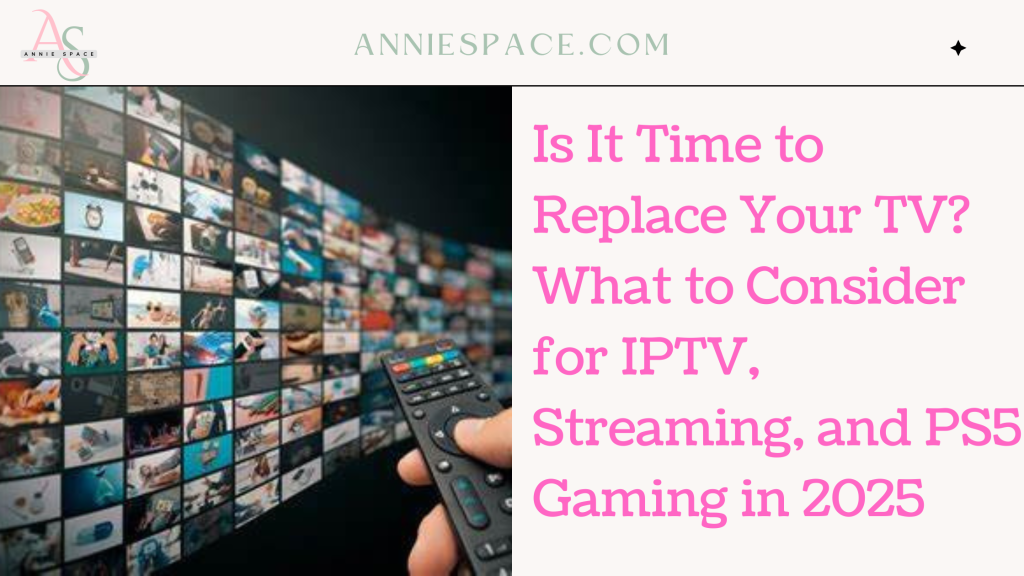When it comes to streaming, IPTV, and PS5 gaming, choosing the right TV can make all the difference. With newer technologies emerging every year, you may be wondering if it’s time to upgrade to something more advanced in 2025. In this article, we’ll explore the factors you should consider when deciding whether it’s time for a new TV, and what features to look for to elevate your viewing and gaming experience.
Key Considerations for TV Upgrades
1. Gaming Performance
For PS5 users, the TV is a critical component to fully enjoying the console’s capabilities. The PS5 supports 4K resolution at 120Hz, HDR, and low input lag, and having a TV that can handle these features is crucial for a smooth and immersive gaming experience.
- Refresh Rate: TVs with 120Hz refresh rates are highly recommended for a smoother gameplay experience, especially for fast-paced games. Lower refresh rates (60Hz) can introduce motion blur and lag, especially noticeable in action games.
- Input Lag: A low input lag (preferably under 20ms) ensures that there’s no delay between your controller inputs and what appears on the screen—vital for competitive gaming.
- HDMI 2.1: For 4K at 120Hz, HDMI 2.1 support is a must. This ensures compatibility with the PS5’s best performance features, like high frame rates and higher resolutions.
2. Picture Quality
While gaming is a major consideration, your TV should also excel in streaming content. Whether you’re watching Netflix, Disney+, or YouTube, the visual quality of your TV plays a large role in your viewing experience.
- Contrast and Blacks: The depth of black levels and contrast is important, particularly for HDR content. OLED TVs are superior in this area, as they can turn individual pixels off to achieve true black, offering a more immersive experience.
- Brightness: Brightness becomes essential if you watch TV in a well-lit room. Newer TVs with higher peak brightness can offer better viewing in bright environments, making it easier to enjoy content during the day without worrying about washed-out images.
- Color Accuracy: Whether you choose OLED, LED, or QD-OLED, the color reproduction is crucial. OLED and QD-OLED TVs offer exceptional color vibrancy, while LED models can still deliver good color but with some limitations in terms of color depth and black levels.
3. Viewing Environment
Your TV’s performance can be significantly impacted by the lighting conditions of the room. If your room is bright or has lots of natural light, it’s essential to consider TVs that can produce a higher level of brightness. Conversely, if you tend to watch in a dark room, OLED or QD-OLED might be ideal, as they provide deep blacks and more vivid colors.
- Bright Rooms: Look for a TV with a high peak brightness, such as newer LED models or mini-LED displays. These technologies are designed to improve the brightness and overall picture quality, even in well-lit environments.
- Dark Rooms: If you watch TV in darker settings, OLED and QD-OLED TVs are excellent choices due to their ability to produce true blacks and exceptional contrast ratios, making them ideal for cinematic viewing.
When Should You Upgrade?
If your current TV is 2–3 years old, it may still meet your needs for basic viewing, but advancements in TV technology are constant. Here are a few signs it might be time to consider upgrading:
- Outdated Gaming Features: If your TV lacks HDMI 2.1 support, struggles with 4K at 120Hz, or has noticeable input lag, it’s time to look into a model that can handle the latest gaming features. This is especially important if you play a lot of fast-paced or competitive PS5 games.
- Picture Quality is Lagging: If you notice that your current TV struggles with HDR, contrast, or doesn’t produce vibrant colors, it might be time for an upgrade. The newer OLED and QD-OLED technologies offer better overall picture quality, especially in dark scenes and for HDR content.
- Need for Better Brightness: TVs with higher peak brightness are essential for bright viewing environments. If you’re finding that your current TV struggles to maintain picture clarity in sunlight or well-lit rooms, it’s worth considering a TV with better brightness handling.
- Aging TV Technology: If your TV is over 4 years old, it might lack newer features such as HDR10+, Dolby Vision, or adaptive refresh rates for gaming. Newer models come with improved smart TV systems, faster processors, and better energy efficiency.
Recommended TV Options in 2025
If you’re ready to upgrade, here are the top options to consider in 2025:
- OLED TVs: For those who prioritize cinematic viewing and gaming, OLED offers the best contrast and color accuracy. The LG C Series or G Series, as well as Sony’s A80L, are excellent choices for those looking for high-end picture quality and gaming performance.
- QD-OLED TVs: Samsung’s QD-OLED TVs, such as the S90D or S95D, combine the best of OLED and Quantum Dot technology, offering brighter colors and superior brightness. These are ideal for gamers who want the best of both worlds: deep blacks and vibrant colors.
- Mini-LED and High-End LED TVs: If you prefer something more budget-friendly or need a TV that performs well in bright rooms, Mini-LED and high-end LED models from Sony (like the X90L) and Samsung (like the QN90B) offer fantastic contrast, brightness, and overall performance.
Budget Considerations
When upgrading to a new TV, costs can vary widely depending on the size, brand, and features you choose:
- OLED TVs: Expect to pay around $1,500–$3,000 (£1,200–£2,500) for a 65-inch model from LG, Sony, or other premium brands.
- QD-OLED TVs: These are generally priced higher, with models ranging from $2,000–$3,500 (£1,500–£2,800).
- Mini-LED or LED TVs: For a more affordable option, expect to spend $1,200–$2,500 (£1,000–£2,000) for high-end LED or Mini-LED models.
Conclusion: Is It Time for an Upgrade?
If you’re a PS5 gamer, a frequent streamer, or just someone who enjoys a high-quality viewing experience, upgrading your TV could be well worth the investment in 2025. Keep in mind your primary usage, whether it’s for gaming, streaming, or watching movies, and consider how important factors like picture quality, brightness, and gaming features are to you.
Whether you go for an OLED, QD-OLED, or high-end LED TV, make sure you choose one that will future-proof your setup and give you the best possible experience for the years to come.



